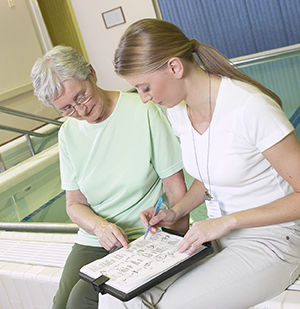Getting Started with Pulmonary Rehabilitation
Pulmonary Rehabilitation: Getting Started
Pulmonary rehabilitation (rehab) programs can help people with chronic lung disease like chronic obstructive pulmonary disease (COPD) which includes emphysema and chronic bronchitis. And, other conditions like cystic fibrosis, pulmonary fibrosis, and sarcoidosis. The programs are provided by healthcare professionals who will:
Teach you the skills you need to live and breathe better
Encourage you to put these skills to good use through lifestyle changes
Help you set realistic goals so you can make these changes gradually and effectively
Pulmonary rehabilitation professionals
The programs are usually led by healthcare providers including nurses and respiratory therapists. The team may also include exercise specialists, physical and occupational therapists, dietitians, pharmacists, and counselors. Although most programs take place in a group setting, these team members will help you one-on-one when you need it. If you are not in a pulmonary rehab program, ask your healthcare provider or nurse about programs in your area.
Pulmonary rehab programs
The programs may include:
Exercise training
Breathing techniques
How to do things more easily
Nutritional support
Information about your condition
Self-management skills
Help to stop smoking
Emotional support
Making changes that work for you
To reach your goals, you’ll probably need to make changes to your lifestyle. To help make changes go more smoothly:
Expect new emotions. It’s common to resist or feel angry or scared about having to make changes. You’re not alone. Share your feelings with the pulmonary rehab team and people close to you.
Prepare yourself for slow, steady progress. Change doesn’t happen overnight. To feel your best, you need to commit yourself to practicing your new skills. Over time, you’ll be stronger, have more control of shortness of breath, and be able to do more. But only if you keep at it.
Get support. Get support from family and friends as you try new things. Tell the people in your life how they can help you reach your goals. Share your ideas and tips for success with other members of your pulmonary rehab group. And don’t be embarrassed to ask for help.
My goals
Are there things you can’t do now that you’d like to be able to do when your pulmonary rehab program is finished? Check off the statements below that may apply to you.
I want to:
☐ Breathe better.
☐ Understand my lung disease and what I can do to feel better.
☐ Have more energy to enjoy my family and friends.
☐ Rely less on others.
☐ Be able to walk further.
☐ Be stronger.
☐ Enjoy my hobbies and leisure activities.
☐ Eat healthier foods.
☐ Quit smoking.
☐ Feel less anxious and depressed about my condition.
☐ Travel and enjoy myself.
☐ Have fewer visits to the hospital or emergency room.
Other goals:
___________________________________________________________
___________________________________________________________
___________________________________________________________
___________________________________________________________
Updated:
March 21, 2017
Reviewed By:
Blaivas, Allen J., DO,Sather, Rita, RN
